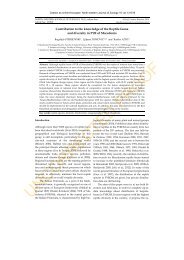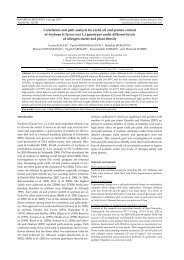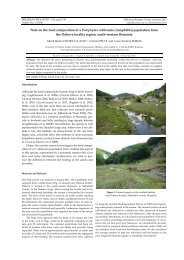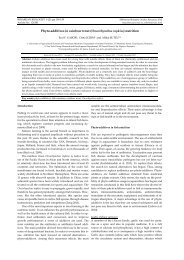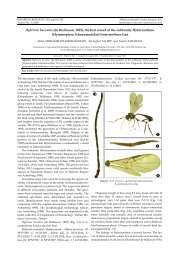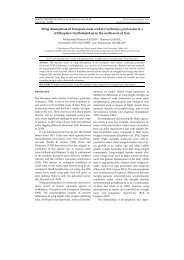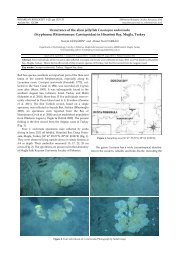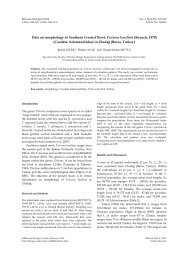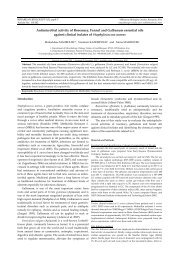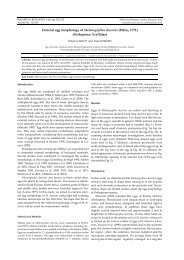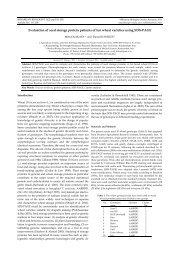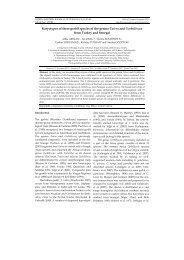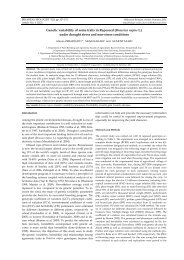New records and zoogeographic classification of amphibians and ...
New records and zoogeographic classification of amphibians and ...
New records and zoogeographic classification of amphibians and ...
You also want an ePaper? Increase the reach of your titles
YUMPU automatically turns print PDFs into web optimized ePapers that Google loves.
Amphibians <strong>and</strong> reptiles from Bosnia <strong>and</strong> Herzegovina<br />
species is strictly endemic to BaH, some subendemic<br />
taxa may be found here. In <strong>amphibians</strong> this<br />
is the case <strong>of</strong> the Dinaric endemic Proteus anguinus<br />
(Sket 1997), or <strong>of</strong> Salam<strong>and</strong>ra atra prenjensis which<br />
is distributed in the southern Dinarides, geographically<br />
presumably isolated from the nominotypic<br />
subspecies from the Alps (Staniszewski<br />
2011). Importance <strong>of</strong> the north-western part <strong>of</strong> the<br />
Balkan Peninsula for herpet<strong>of</strong>aunal diversity may<br />
be further demonstrated by several unique lizard<br />
taxa distributed only in this region such as Dalmatolacerta<br />
oxycepahala, Dinarolacerta mosorensis, Dinarolacerta<br />
montenegrina or Podarcis melisellensis<br />
(Arnold & Ovenden 2002, Podnar et al. 2004, Arnold<br />
et al. 2007, Ljubisavljević et al. 2007).<br />
Despite the importance <strong>of</strong> BaH for underst<strong>and</strong>ing<br />
the amphibian <strong>and</strong> reptile zoogeography<br />
in the Balkan Peninsula, the information on recent<br />
distribution <strong>of</strong> herpet<strong>of</strong>auna remains vastly incomplete.<br />
Few contributions were published at the<br />
end <strong>of</strong> the 19 th century <strong>and</strong> during the 20 th century<br />
(Tomasini 1894, Werner 1897, 1899, 1907, Bolkay<br />
1919, 1924, 1929, Radovanović 1941, Frommhold<br />
1963), while the only attempts to summarize all<br />
known information on reptiles <strong>of</strong> BaH are those <strong>of</strong><br />
Veith (1925, published in 1991a,b). It is obvious<br />
that even the complex atlas <strong>of</strong> the distribution <strong>of</strong><br />
European herpet<strong>of</strong>auna shows highly incomplete<br />
information on the distribution <strong>of</strong> many amphibian<br />
<strong>and</strong> reptile species in BaH (cf. Gasc et al. 1997).<br />
The aim <strong>of</strong> our study is thus to bring recent data<br />
on the distribution <strong>of</strong> <strong>amphibians</strong> <strong>and</strong> reptiles in<br />
BaH <strong>and</strong> classify the region <strong>of</strong> BaH <strong>zoogeographic</strong>ally.<br />
Material <strong>and</strong> Methods<br />
In late August, early September <strong>and</strong> late October 2010 we<br />
collected data on distribution <strong>of</strong> <strong>amphibians</strong> <strong>and</strong> reptiles<br />
at 31 localities representing most regions <strong>of</strong> Bosnia <strong>and</strong><br />
Herzegovina (Table 1, Fig. 1). The species were identified<br />
according to Arnold & Ovenden (2002) <strong>and</strong> taxonomy<br />
<strong>and</strong> nomenclature was adopted from Speybroeck et al.<br />
(2010). The faunistic <strong>records</strong> were usually documented<br />
with photographs <strong>of</strong> both specimens <strong>and</strong> habitats. We<br />
took GPS coordinates (WGS 84) <strong>and</strong> altitude <strong>of</strong> all localities<br />
as well as all other relevant faunistic data. The distribution<br />
data <strong>of</strong> individual species or species complexes<br />
were recorded into 50 x 50 km Universal Transverse Mercator<br />
(UTM) maps to be comparable to those <strong>of</strong> Gasc et al.<br />
(1997) (see Fig. 2). Chorotypes were identified according<br />
to the <strong>classification</strong> <strong>of</strong> Vigna Taglianti et al. (1999) <strong>and</strong> in<br />
chelonians <strong>and</strong> lizards with respect to Sindaco & Jeremčenko<br />
(2008). Subsequently we compared the chorotype<br />
structure <strong>of</strong> the herpet<strong>of</strong>auna <strong>of</strong> BaH with that <strong>of</strong> three<br />
325<br />
regions <strong>of</strong> the Balkan Peninsula: the North-Western (NW)<br />
Balkans (defined here as Croatia <strong>and</strong> Slovenia), the Eastern<br />
(E) Balkans (Bulgaria <strong>and</strong> Romania) <strong>and</strong> the Southern<br />
(S) Balkans (Albania <strong>and</strong> Greece, excluding Crete <strong>and</strong><br />
Eastern Aegean Isl<strong>and</strong>s). Data on the presence <strong>of</strong> the taxa<br />
follow Gasc et al. (1997), for Greece <strong>and</strong> Bulgaria with respect<br />
to recent publications (Valakos et al. 2008, Stojanov<br />
et al. 2011).<br />
Results<br />
The list <strong>of</strong> all recorded species can be found in Table<br />
1 (for locality position see Fig. 1). In total, we<br />
recorded 29 amphibian <strong>and</strong> reptile species representing<br />
61.7% <strong>of</strong> the total number <strong>of</strong> known species<br />
<strong>of</strong> BaH (47 species), 12 <strong>of</strong> which were represented<br />
by <strong>amphibians</strong> (from 18 species in total,<br />
which is 66.7%) <strong>and</strong> 17 were represented by reptiles<br />
(29 species, 58.6%). The recorded species belonged<br />
to 12 families: Proteidae (1 species), Salam<strong>and</strong>ridae<br />
(3), Bombinatoridae (1), Bufonidae (2),<br />
Hylidae (1), Ranidae (4), Lacertidae (6), Anguidae<br />
(2), Colubridae (4), Natricidae (2), Psammophiidae<br />
(1), Viperidae (2). In comparison with the distribution<br />
maps from Gasc et al. (1997), we found new<br />
50 x 50 km UTM grid <strong>records</strong> in 8 amphibian species:<br />
Triturus cristatus complex, Bombina variegata,<br />
Bufo bufo, Bufo viridis complex, Hyla arborea, Rana<br />
temporaria, Rana dalmatina, Pelophylax ridibundus<br />
<strong>and</strong> 9 reptile species: Lacerta agilis, Lacerta viridis<br />
complex, Podarcis muralis, Anguis fragilis complex,<br />
Coronella austriaca, Hierophis gemonensis, Natrix natrix,<br />
Natrix tessellata <strong>and</strong> Zamenis longissimus (see<br />
Fig. 2). In total we recorded 84 faunistic items in 14<br />
50 x 50 UTM quadrates (35.9% from 39 quadrates<br />
covering BaH). The most <strong>of</strong>ten recorded amphibian<br />
species was B. bufo (7 localities, 5 quadrates), P.<br />
ridibundus (4, 3) <strong>and</strong> B. variegata (3, 3). The most<br />
common reptile species was P. muralis (12, 8). The<br />
green lizards <strong>of</strong> the L. viridis complex (11, 8) <strong>and</strong><br />
slow worms <strong>of</strong> the A. fragilis complex (9, 8) were<br />
also relatively common.<br />
On the other h<strong>and</strong> we did not find some other<br />
species known to occur in areas within the mapping<br />
grids covering BaH (sensu Gasc et al. 1997):<br />
S. atra, I. alpestris, Bombina bombina, Pelobates fuscus,<br />
Pelophylax kl. esculentus, Mauremys rivulata, Emys<br />
orbicularis, Testudo hermanni, Hemidactylus turcicus,<br />
Algyroides nigropunctatus, D. mosorensis, Podarcis<br />
siculus, Zootoca vivipara, Elaphe quatuorlineata,<br />
Zamenis situla, Telescopus fallax <strong>and</strong> Vipera ursinii.<br />
However, many <strong>of</strong> these species probably inhabit<br />
BaH only marginally (cf. Gasc et al. 1997).



